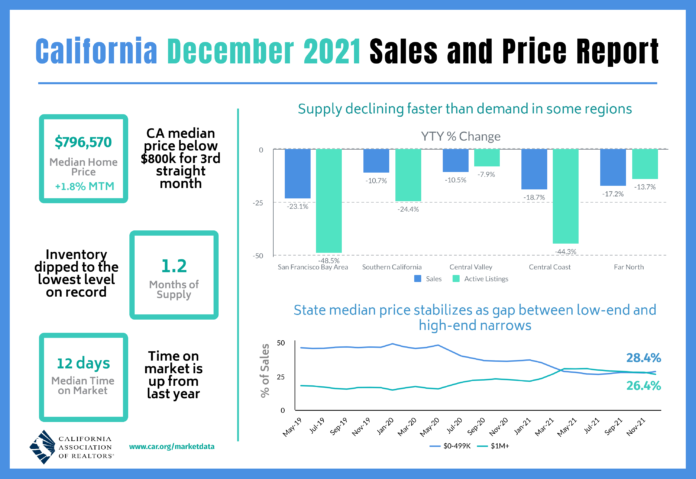California’s housing market kicked off the new year with a bounce-back in sales from December’s four-month low, as housing demand remained strong by pre-pandemic standards, reveals the California Association of Realtors (CAR).
Closed escrow sales of existing, single-family detached homes in California totaled a seasonally adjusted annualized rate of 444,540 in January, according to information collected by CAR from more than 90 local REALTOR associations and MLSs statewide. The statewide annualized sales figure represents what would be the total number of homes sold during 2022 if sales maintained the January pace throughout the year. It is adjusted to account for seasonal factors that typically influence home sales.
January’s sales pace was up 3.4% on a monthly basis from 429,860 in December and was down 8.3% from a year ago, when 484,760 homes were sold on an annualized basis. The year-over-year sales decrease was the seventh straight decline and the smallest in six months.
“The buoyant housing market continues in 2022 as buyers returned from the holiday season to take advantage of the still favorable lending environment before interest rates climb further,” says CAR President Otto Catrina, a Bay Area real estate broker and realtor. “With prices leveling off, housing supply showing a slight improvement and competition easing during the off season, buyers who missed the opportunity to buy were eager to get back to the market at the start of the new year.”
California home prices continued to decelerate as a shift in the mix of sales toward less expensive homes and seasonal slowdown continued. The statewide median price declined to $765,580 in January, down 3.9% from December’s $796,580 and was up 9.4% from the $699,920 recorded in January 2021. While January marked the first time since July 2020 that the state did not record a double-digit annual gain in its median price, the statewide median price is expected to edge higher as the market moves into the spring home buying season in the next few months.
“It’s encouraging to see the market momentum from the last two years being carried forward into 2022 and the economy continuing to recover. January’s sales remained above pre-pandemic levels, and new purchase mortgage applications are still registering strong numbers,” states Jordan Levine, CAR’s vice president and chief economist. “However, a surge in interest rates in the past few weeks is concerning and will likely create affordability headwinds for buyers, which may result in housing demand being curtailed in the upcoming months.”
At the regional level, nearly all major regions in California recorded a decrease in sales on a year-over-year basis, but lower-priced areas exhibited more moderate declines in general when compared to last year. The San Francisco Bay Area — which had a sales surge of 31.8% in January 2021 — had the biggest year-over-year sales decline of all regions at -22.3%. Central Coast (-20.7%) and Southern California (-10.1%) also experienced double-digit sales losses in January. Home sales in the Central Valley region dipped as well but at a more moderate pace of -3.9%, while sales in the Far North (1.9%) actually increased slightly from last year.
Three-quarters of the counties tracked by C.A.R. experienced a year-over-year sales decline in the first month of 2022, with 26 counties sliding more than 10% from a year ago. Marin continued to be the county with the biggest sales drop, falling by 40% from the same month a year ago. Amador (-35%), San Luis Obispo (-34.2%), and Santa Cruz (-32.3%) were three other California counties that also experienced a drop of more than 30% in January.
Counties that posted a year-over-year sales decline had an average decrease of -16.3% in January. Thirteen counties recorded an increase in sales from last year, with Yuba (100%) surging the most, followed by Sutter (53.2%) and Tehama (25.8%).
Home prices continued to grow in all five major regions in the state, with all five of them recording double-digit annual price increases in January. The Central Valley region had the highest year-over-year price gain with a 17.5% increase, followed by the San Francisco Bay Area (14.3%), Southern California (13.8%), the Far North (13.4%) and the Central Coast (10.9%).
Home prices, in general, continue to rise across the state, with 45 counties showing a year-over-year increase in median price in January. Thirty-three of them had a double-digit gain from a year ago with Plumas surging the most at 46%, followed by Tehama (43.6%) and Glenn (34.3%). Median prices declined in six counties with Mono dropping the most at -14.6%, followed by Mariposa (-12.5%) and Del Norte (-6.6%).
Market competitiveness was less heated than a few months ago but remained elevated in January. While the statewide median sales-price-to-list-price ratio remained above 100%, the January figure was the lowest level since February 2021. Nearly three-fifths of homes (57.3%) still sold above asking price in the latest monthly report but was the lowest level in 11 months.
California’s Unsold Inventory Index (UII) rose in January as new active listings increased 37.2% from December. January’s UII was 1.8 months and 1.4 months in January 2021. The index indicates the number of months it would take to sell the supply of homes on the market at the current rate of sales.
The median number of days it took to sell a California single-family home was 12 days in January and 11 days in January 2021.
CAR’s statewide sales-price-to-list-price ratio was 101.2% in January 2022 and 100.2% in January 2021. The statewide average price per square foot for an existing single-family home remained elevated. January’s price per square foot was $372, up from $331 in January a year ago.
The 30-year, fixed-mortgage interest rate averaged 3.45% in January, up from 2.74% in January 2021, according to Freddie Mac. The five-year, adjustable mortgage interest rate averaged 2.57%, compared to 2.87% in January 2021.











